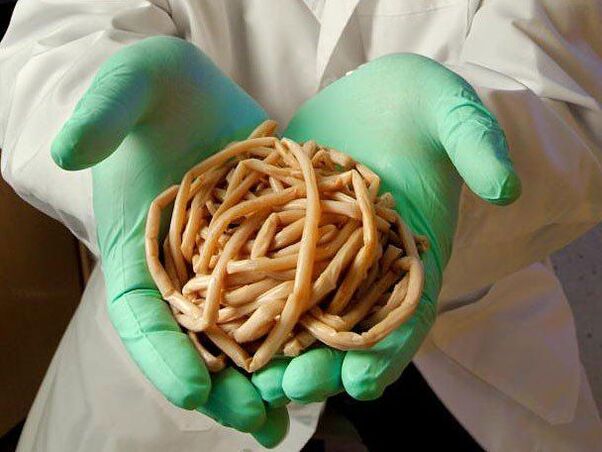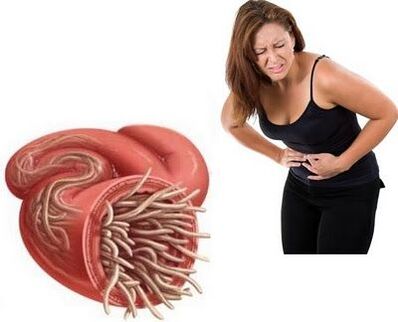Parasites - This is the name of one of the most common groups of infectious diseases.Today around 300 parasites are known that pose a danger to people, including a fatal.On the territory of the European continent, these are just a few dozen parasites (medical name - helminthia, helminthic invasion).
Most of parasites that are relevant to humans are common in countries with a tropical and subtropical climate as well as to a low level of socio -economic development and sanitary culture.
What are the dangerous parasites?

Parasites in the human body can influence almost any organ system.The degree of damage depends on the type of helminther, the duration of the disease, the initial state of health.The earlier the diagnosis of a specific helminthian invasion is determined, the more chances to get rid of the parasites quickly.For this reason, it is important to diagnose the condition of the invasion with parasites in good time and to carry out all of the treatment stages.
Almost every variant of helminthiasis, especially for a long time, harms the human body significant damage.The invasion of HLYBON is the reason for the delay in psycho-engine development in children of all ages and significantly reduces performance and life reserves in adults.
Regardless of the age of a person, the helminthic invasion contributes to allergization, reduces the ability of the immune system to resist infectious and other diseases, in addition to the effectiveness of ongoing vaccine prophylaxis.
In rare cases, cleaning the body of parasites is spontaneously, in most cases this is required according to a specific scheme.
What are parasites

Parasites (they are also worms or worms) are an extensive group of complex organisms with multi -cell, in different conditions in an active condition.An important feature is the ability to exist within another living organism (person or animal), which is called "invasion".
Various types of parasites in the human body are currently known.The most common classification of parasites depending on their external structure and the characteristics of the life cycle.
In view of the biological characteristics, all parasites are divided into 3 large classes:
- Round worms (they are also nematodes), for example Trichinella, Ankylostoma, Pin, Ascaris;
- Tapeworms (they are also cestodes), for example alveococcus, echinococcus, band wide, bullish clinical tapen, pork and dwarf;
- Super (they are also tremontodes), for example opistrch, fasciol, clonorch.
In addition, like many other diseases, parasitic diseases differ:
- By heavy;
- by the leading syndrome, that is, which system of organs is damaged to a greater extent;
- through the presence and nature of the complications;
- Due to the possible result of the disease.
Features of parasites
Stage of development
Parasitic diseases are characterized by a number of differences associated with the characteristics of parasites and their life cycle.
The number of adults of parasites in the human body does not increase, provided there is no new infection.To implement the life cycle, most parasites need a change in the habitat (animal body, soil, etc.).
The levels of development are typical for every parasite.During the entire life cycle, HELMINTH carries out a number of consistently changing development stages of development.As a rule, the parasite is transformed into a larva and further into an adult individual.The reverse development does not occur, the egg cannot immediately go to the stage of an adult.
The parasite penetrates the human body at a stage of its life cycle and goes outside into another.At this moment, the non -treatment of the practical persons of human parasitic diseases is associated.This means that it is impossible to have a large part of the parasitic diseases infected in direct contact with an infected person.
Possible ways of penetration into the human body
In many types of parasites, one person can meet anywhere - they are not visible to the mere eye.The following options are most likely:
- the oral path, i.e. with non -compliance with personal hygiene, the use of dirty or thermally unprocessed products;
- The percutaneous path, i.e. larvae or adults of parasites, penetrate the human body due to damage to the skin when they come into contact with water or soil, with the involvement of blood -sensitive insects.
Most parasites that influence the human body only live in the adult stage, mainly in the digestive tract.These are the so -called intestinal parasites (helminthen).They are in turn divided into two groups according to a few characteristics.
The intestinal parasites of the first group enter the human body in the form of an egg.In the digestive tract, they are transformed into an adult individual.The movements of such parasites (pinworms, a wide ribbon, pork and bull strap worm) are only limited by various departments of the digestive tract.
Representatives of the second group (their larvae or eggs) carry out a significantly longer and complex migration according to various tissues and organs of the human body.Only then is there an adult individual of the educated parasite.It is clear that the symptoms of such parasitic diseases are much more diverse, since the migration process is associated with significant changes in the body.
Parasites that are located in the stage of an adult or a larvae outside the digestive tract are referred to as tissue.If there is only a parasite in the human body in the stadium of the larvae, then a person is an ecological dead end for him that HELMIN cannot leave.
Features of the life cycle of parasites
In order to know how to get rid of parasites in the body, it is necessary to present your life cycle in general.This knowledge also helps to prevent parasites from penetrating the human body.
In accordance with the characteristics of the life cycle, all parasites are divided into:
- Geo parasites;
- infectious helminther;
- Organic helminthiasis.
In order to implement the life cycle of GEO parasites (Vlasov, a non -core), it is necessary that the eggs are in the ground for a certain time.In the future, with direct contact with dirty soil, penetrate parasites insufficiently washed vegetables through dirty hands into the human body.
In contagiostal parasites (pinworms, dwarf vibes), all stages of development only appear in the human body without changing in the environment.Only these types of parasitic diseases are transferred directly from person to person.In childhood in particular, it is also possible to generations of REAuto, i.e. in the event of non -compliance with hygiene rules and capabilities.
The most complex life cycle in the stated Biumelmintosis.A prerequisite for the implementation of your life cycle is the presence of an intermediate host.One person can either be an intermediate product or the last master.For example, a person with echinococcosis is an intermediate host and dogs and cats are final.In the case of a tusherin chose, representatives of cattle are on the contrary, one person and one person are final.
Symptoms of parasites
The clinical signs of parasites on the one hand are determined by the prevailing damage to a certain organ.On the other hand, they have general features that enable us to distinguish an acute and chronic stage of a parasitic disease.
The acute phase of a parasitic disease corresponds to the migration stage of the developing helminths.It manifests itself in clinical signs such as allergic and general toxic reactions (ascariasis, schistosomosis, fasciolesis, trichinellosis).
The immunological component has a significant weight in the development of the acute phase of parasitosis, forms a certain stereotype of the clinical image and some similarities with other immunological reactions of non -infectious nature - medicinal products, allergic dermatitis and others.
The hidden period with most parasitosis is several weeks, with a massive infection version is reduced to 7-10 days and extended with poor intensity.
The main symptoms of parasitic diseases are as follows:
- Increased body temperature - from subfebil to very high;
- Pain in the muscles and joints, different duration and intensity;
- The formation of a rash on the entire surface of the skin, different in size and intensity, accompanied by skin itching;
- Significant edema of skin and subcutaneous tissue, less often - mucous membranes;Most typical for trichinellosis that gave the disease a characteristic popular name "swollen";
- the development of lung syndrome, namely night cough, astmitoid states, the formation of pneumonia with a wandering focus of damage;
- the development of abdominal syndrome, which is characterized by moderate abdominal pain, liquid stool without impurity of mucus and blood;
- In severe cases, damage to the central nervous system and the heart is observed;
- A characteristic characteristic of helminthiasis are changes in peripheral blood: pronounced leukocytosis and significant eosinophilia (up to 30-40%).
In treatment in the stage of the acute phase of medicinal products from parasites in the human body most effective.
In the stage of the chronic phase of parasitic diseases, the harmful effect is determined by the type of adult parasite.The adverse effect on the human body is associated:
- larger toxic and less allergic effects;
- Mechanical damage to tissues in the parasitization zone (e.g. liver echinococcosis);
- the absorption of nutrients, a violation of metabolic processes, the development of anemia and cachexia;
- serious anemia;
- increased irritability and excitability of a person;
- It is possible to join secondary infection and dysbiosis, the weight of the course of other infectious and non -infectious diseases and pregnancy.
The duration of the existence of individual parasites is different - from several days and weeks (cutters) for up to many years.After a parasitic illness, a RE function is possible because no immunity is formed.Time cleaning of the body from parasites therefore does not protect against a repeated episode of the disease.
Treatment of parasites

The classic drug therapy of parasitosis in the present has achieved considerable success.The introduction to the clinical practice of connections between Benzimidazole and Imidazole made it possible to successfully treat many types of helminthia.
These drugs have a wide range of exposure, a small toxide with short treatment when adults and children are convenient to use.The corresponding age of the drug dose should be observed.
How to clean the body of a certain parasite, which treatment scheme to choose and which medication is decided by the doctor.It is not recommended to prevent helminthiasis for the personal initiative because the addiction to medicinal products develops, ie a decrease in their effect.
Cleaning parasites
In parasitosis, treatment with folk remedies is no less popular than the means of traditional medicine.Supporters of the natural instruments for parasitic diseases focus on the security and universality of such therapy.There is a large recipe for traditional medicine with which you can effectively finish effectively with parasites in the human body.The following options for eliminating parasites in the human body are the best known:
- Coriander and pumpkin seeds as prophylactic and therapeutic active ingredients for parasites;
- Alcohol tincture on Channelle in combination with white mushrooms;
- a decoction of pine cones;
- Tincture of the green walnuts.
All folk remedies for parasites should be created in harmony with the recipe and the clean hands.Before choosing a specific recipe, it is important to ensure that a person has no allergy to the ingredients that are part of medicine.
How you can protect yourself against parasites

It is both simple and difficult at the same time.Several simple rules help to minimize the risk of infection with a parasite:
- Wash your hands thoroughly;
- the right habit of using a single row of dishes;
- Process all thermal meat and fish fish, with caution dried and salty fish and meat population.
- Treat vegetables and fruit with boiling water (after washing in running water);
- Always wash your hands with soap after communicating with animals (even domestic).
A parasit infection at all ages is an unpleasant problem, but the early treatment completely eliminates.








































